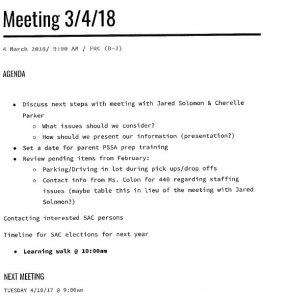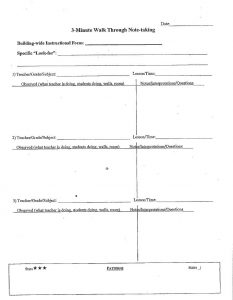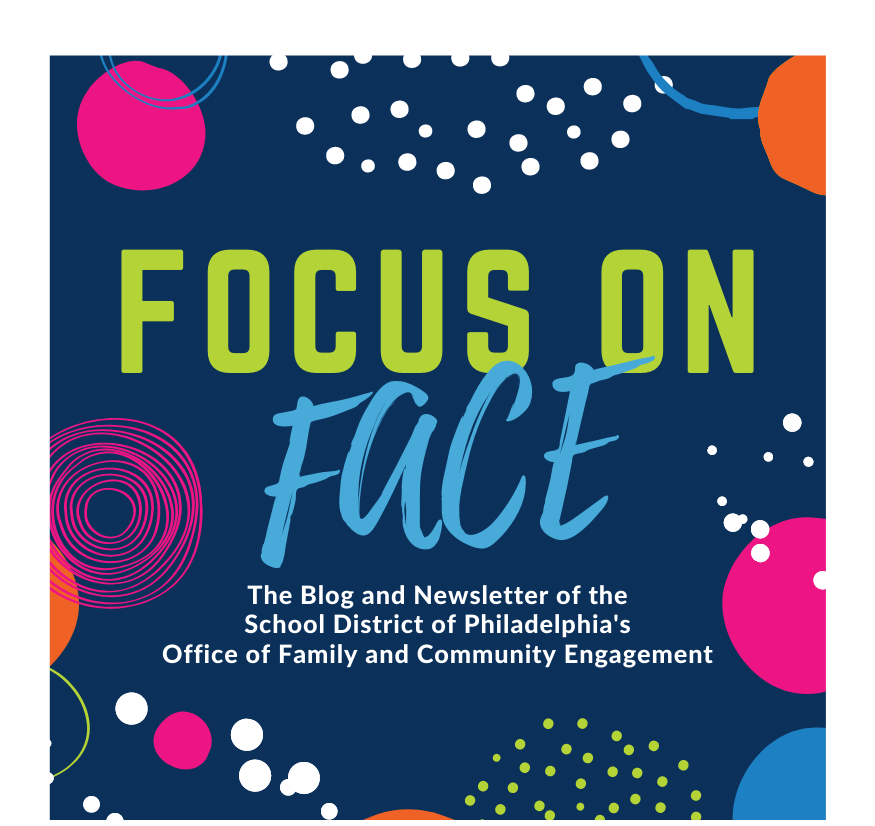 Laura H. Carnell Elementary School is located in Northeast Philadelphia and has nearly 1,000 students enrolled in grades K-5. Carnell currently holds SAC meetings once a month, usually on a Tuesday morning right after the hustle and bustle of drop-off. In March, Carnell held a SAC meeting attended by parents, the Vice Principal, and the school’s Community Partnerships Coordinator. The agenda was distributed, and the SAC Facilitator got right down to business.
Laura H. Carnell Elementary School is located in Northeast Philadelphia and has nearly 1,000 students enrolled in grades K-5. Carnell currently holds SAC meetings once a month, usually on a Tuesday morning right after the hustle and bustle of drop-off. In March, Carnell held a SAC meeting attended by parents, the Vice Principal, and the school’s Community Partnerships Coordinator. The agenda was distributed, and the SAC Facilitator got right down to business.
The first order of business was to discuss concerns about chronic teacher absences and how to combat this issue with limited resources. The SAC also briefly discussed other areas of concern, such as needing more people to monitor hallways and the lunchroom. The SAC meeting was very efficient: a problem was presented and the SAC members proposed various solutions or steps towards a resolution.
SAC members moved on to the next agenda item, which was to decide when to host a PSSA prep training for parents. At this point, it was only 15 days until the PSSA. The SAC’s biggest concern was getting a huge turnout. They realized they needed to plan this training around Spring Break. Each SAC member brought up considerations that the Vice Principal should keep in mind when choosing the date in order to have the best turnout. For example, evening hours may cater to parents with full-time jobs and having the training close to when Spring Break begins or ends might negatively affect turnout.
The SAC members digressed from the agenda for a moment to discuss ways that they could incorporate opportunities for parents to fill out the district-wide parent surveys at school events. This is a great example of the efficiency of Carnell’s SAC: a quick deviation from the agenda items for a few minutes to bring in a problem that could easily be discussed in conjunction with another issue, and then they went straight back to the agenda.
With the next two agenda items swiftly covered and a plan of action put into motion, the SAC then began one of the most interesting parts of the SAC meeting: a “learning walk.”
During a learning walk, the SAC members choose about three or so classrooms in a given grade level to walk through. They observe how the classroom is set up, how the teachers are engaging the students, and what content the students are learning. There’s a note-taking sheet SAC members use to write down their observations about what the teachers and students are doing and any notes or questions they want to discuss during a future SAC meeting. Learning walks are great ways to get SAC members in classrooms to see what is really going on in the school and if there are ways the SAC believes it can help support teachers.
The learning walk at Carnell focused on first grade and kindergarten classrooms. The lower grades at Carnell are located in an annex building that’s across the blacktop from the main building. The SAC observed three classrooms. During the first observations, the classrooms were doing “centers,” which is more relaxed enrichment. Students were split into different groups and working on different tasks, which included word work, read-to-self, writing, read with the teacher, and technology—using online programs to reinforce reading or mathematics.
The SAC observed the second classroom while it was centers time as well. In this classroom, students were extremely focused on what they were doing. Some were playing number games; others were using computer programs to access reading applications; some were doing arts and crafts.
By the time the SAC went to the third classroom of the learning walk, centers time was over. In the third classroom, a fifth grade teacher, helping to cover the kindergarten classroom, led students through a math worksheet.
The learning walk was a very informative experience for SAC members. Sometimes learning walks can shed light on issues that need the SAC’s attention or matters where the SAC can provide some support. After the learning walk, the SAC members were already discussing some topics they’d like to discuss at the next SAC meeting based on what they saw during the activity. Learning walks are not only a creative and very useful activities to do during SAC meetings; they also energize members and function as a tool to work towards improving the school community.



